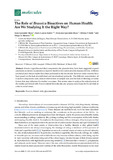Mostrar el registro sencillo del ítem
The role of brassica bioactives on human health: are we studying it the right way?
| dc.creator | Quirante-Moya, Sarai | es_ES |
| dc.creator | García-Ibáñez, Paula | es_ES |
| dc.creator | Quirante-Moya, Francisco | es_ES |
| dc.creator | Villaño Valencia, Débora | es_ES |
| dc.creator | Moreno, Diego A. | es_ES |
| dc.date.accessioned | 2024-03-20T17:50:11Z | |
| dc.date.available | 2024-03-20T17:50:11Z | |
| dc.date.issued | 2020 | |
| dc.identifier.citation | Quirante-Moya, S., García-Ibañez, P., Quirante-Moya, F., Villaño, D., Moreno, D. A. (2020) The role of brassica bioactives on human health: are we studying it the right way?. Molecules, 25(7), 1-14. https://doi.org/10.3390/molecules25071591. | en |
| dc.identifier.issn | 1420-3049 | |
| dc.identifier.uri | https://hdl.handle.net/2454/47766 | |
| dc.description.abstract | Brassica vegetables and their components, the glucosinolates, have been suggested as good candidates as dietary coadjutants to improve health in non-communicable diseases (NCDs). Different preclinical and clinical studies have been performed in the last decade; however, some concerns have been posed on the lack of established and standardized protocols. The different concentration of bioactive compounds used, time of intervention or sample size, and the lack of blinding are some factors that may influence the studies’ outcomes. This review aims to analyze the critical points of the studies performed with Brassica-related biomolecules and propose some bases for future trials in order to avoid biases. | en |
| dc.description.sponsorship | This research was partially supported by Fundación Seneca, Murcia Regional Agency for Science and Technology, Project 20855/PI/18. | en |
| dc.format.mimetype | application/pdf | en |
| dc.language.iso | eng | en |
| dc.publisher | MDPI | en |
| dc.relation.ispartof | Molecules 2020, 25(7), 1591 | en |
| dc.rights | © 2020 by the authors. Licensee MDPI, Basel, Switzerland. This article is an open access article distributed under the terms and conditions of the Creative Commons Attribution (CC BY) license. | en |
| dc.rights.uri | http://creativecommons.org/licenses/by/4.0/ | |
| dc.subject | Brassica | en |
| dc.subject | Clinical trials | en |
| dc.subject | Glucosinolates | en |
| dc.title | The role of brassica bioactives on human health: are we studying it the right way? | en |
| dc.type | Artículo / Artikulua | es |
| dc.type | info:eu-repo/semantics/article | en |
| dc.date.updated | 2024-03-20T17:25:42Z | |
| dc.contributor.department | Agronomía, Biotecnología y Alimentación | es_ES |
| dc.contributor.department | Agronomia, Bioteknologia eta Elikadura | eu |
| dc.contributor.department | Institute on Innovation and Sustainable Development in Food Chain - ISFOOD | en |
| dc.rights.accessRights | Acceso abierto / Sarbide irekia | es |
| dc.rights.accessRights | info:eu-repo/semantics/openAccess | en |
| dc.identifier.doi | 10.3390/molecules25071591 | |
| dc.relation.publisherversion | https://doi.org/10.3390/molecules25071591 | |
| dc.type.version | Versión publicada / Argitaratu den bertsioa | es |
| dc.type.version | info:eu-repo/semantics/publishedVersion | en |



